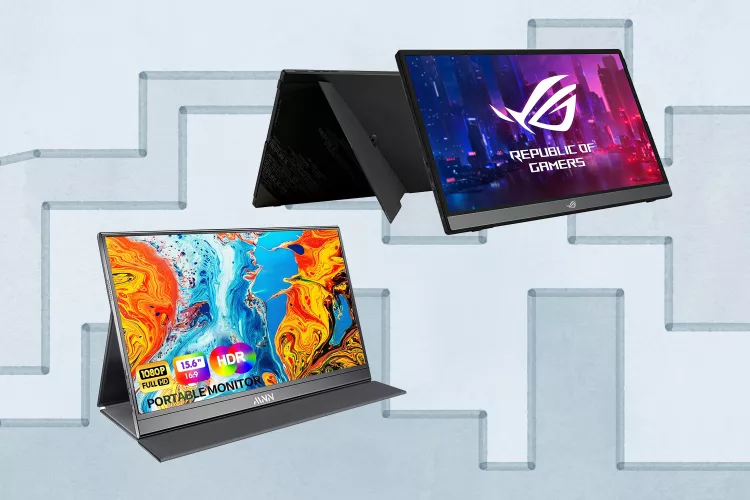We independently evaluate all of our recommendations. If you click on links we provide, we may receive compensation.
Improve your productivity and playtime on the road with one of these lightweight second screens.
Fact checked by
In This Article
Arguably one of the most frustrating things about being on the road is giving up your precious double- or triple-monitor setup and making do with only a small laptop, tablet, or smartphone display instead. If you see your productivity taking a nosedive—or even your pleasure in watching movies or playing games diminishing—then it’s time to add a portable monitor to your bag to reclaim the screen space you’re missing.
The best portable monitors instantly extend your visual workspace, increasing your options for blazing through emails while simultaneously playing reruns of your favorite show or working on a tedious spreadsheet that requires multiple browser windows instead. Best of all, these options all weigh less than 3 pounds, so you won’t have to worry about adding too much bulk either.
Our Top Picks
Best Overall:
ASUS ZenScreen GO 15.6″ IPS LCD FHD Monitor at Amazon $449
Best Attachable:
SideTrak Swivel Attachable Portable Monitor at Amazon $280
Best Budget:
MNN Portable Monitor 15.6inch FHD at Amazon $90
Best Widescreen:
Dell 14 Portable Monitor at Amazon $400 $315
Best Triple-screen:
Xebec Tri-screen 2 at Amazon $493
Best Lightweight:
Lenovo ThinkVision M14 Portable Monitor at Walmart $270
Best Touchscreen:
SideTrak Solo 4K Touch 15.6-inch at Amazon $430
Best for Gaming:
ASUS ROG Strix 15.6-inch at Amazon $299
Tips for Buying a Portable Monitor
Consider the connections and power source
A portable monitor is only a welcome addition to your electronics collection if it can properly hook up to your devices, and that means you’ll need to understand which connections you have. You’ll notice that USB-C and micro-HDMI connections are the most common, so if your device doesn’t have those, then you’ll need to purchase an adapter. You’ll also want to check whether the portable monitor has a built-in battery (and how long that life is, if so), so you know how it will get power. If there’s no built-in battery, you’ll need to draw charge from your laptop (through a USB-C cable) or rely on an AC power outlet.
Know your use cases
Are you planning to use your portable monitor to watch movies? Is it mostly for business trips with no standalone monitor for work or presentations? Will it be used primarily for after-hours gaming? There are plenty of jack-of-all-trades portable monitors that can handle all three of those scenarios with ease, but some brands and models truly excel at just one of those use cases; if you are focused on mainly using it for one specific task, make sure you’re choosing a model that shines in that area.
Choose a size that makes sense for you
Even though we’re somewhat conditioned to think bigger is better with certain displays—like a big screen TV or larger smartphone—that may not necessarily be the case for your portable monitors. If you plan to mostly use it as an extra monitor while working remotely at home, larger sizes may be appealing. But if your plan is to take it on the road for vacations, business trips, or a generally nomadic lifestyle, a more compact option would be ideal for space-saving purposes.
Frequently Asked Questions
- How do portable monitors connect to computers, phones, and tablets?
It depends on the model, but the most common ways are through USB-C, USB-A, or HDMI cables. Usually, the product will come with the essential cables for most setups, but you may find it necessary to buy an adapter depending on which ports your device has. Some portable monitors also offer screen mirroring, which allows you to wirelessly duplicate or extend your phone or tablet screen to the portable monitor.
- Can you use a portable monitor on its own?
Portable monitors are designed to extend your display—whether that’s from a phone, laptop, or tablet. However, like a desktop monitor, a portable one has no independent functionality as it’s not a computer or a television.
- How are portable monitors powered?
Some portable monitors gain “pass-through” power through the USB cord that links the monitor with your laptop. Others come with an AC adapter or power brick that you can connect to an outlet. Finally, some portable monitors have built-in rechargeable batteries that you can operate independently without the need for a power source as long as they are charged up—but know that battery life is typically only a few hours on these.
- Can I bring a portable monitor on a plane?
Yes, bringing a portable monitor on a plane is no different than bringing a laptop, tablet, or portable keyboard in your carry-on or personal item—these electronics are of no concern to TSA or airlines. However, you’ll want to be sure you have enough room to use it without encroaching on your seatmate’s space. With limited tray-table space, you may discover there just isn’t enough surface area for your portable monitor in-flight and only at your final destination.




